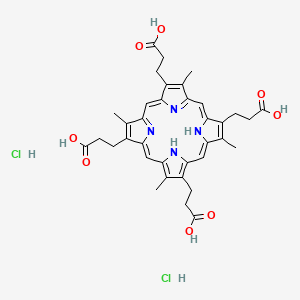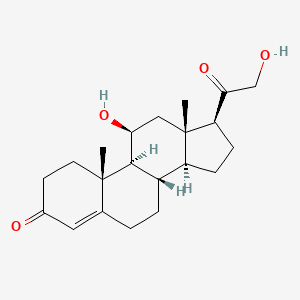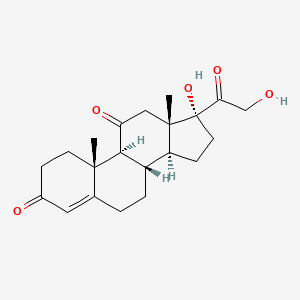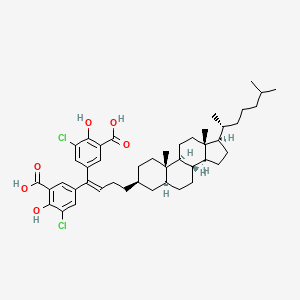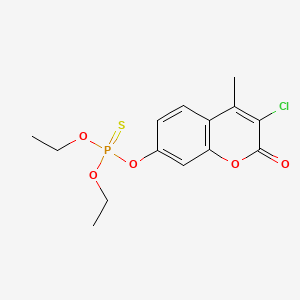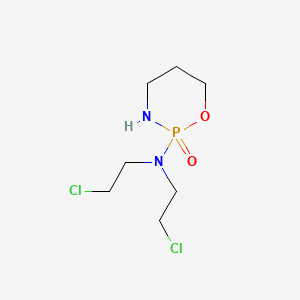
Ciclofosfamida
Descripción general
Descripción
Cyclophosphamidee is a synthetic compound belonging to the class of alkylating agents, specifically nitrogen mustards. It is widely used in chemotherapy and immunosuppressive therapy. Cyclophosphamidee is known for its effectiveness in treating various types of cancers, including lymphomas, leukemias, and solid tumors, as well as autoimmune diseases .
Mecanismo De Acción
Target of Action
Cyclophosphamide is an alkylating agent that primarily targets DNA . It prevents cell division by cross-linking DNA strands and decreasing DNA synthesis . This makes it particularly effective against rapidly dividing cells, such as cancer cells .
Mode of Action
Cyclophosphamide is a prodrug that must be metabolized in the liver to form the active metabolites, phosphoramide mustard and acrolein . Phosphoramide mustard forms DNA crosslinks both between and within DNA strands at guanine N-7 positions . This cross-linking leads to cell death as it prevents the normal functioning of DNA, including replication and transcription .
Biochemical Pathways
The metabolism of cyclophosphamide involves a complex bioactivation pathway. Hepatic enzymes first convert cyclophosphamide to hydroxycyclophosphamide, which is then subsequently metabolized to aldophosphamide . The majority of the antineoplastic effects of cyclophosphamide are due to the phosphoramide mustard formed from the metabolism of the drug .
Pharmacokinetics
Cyclophosphamide undergoes activation to eventually form active metabolites, phosphoramide mustard and acrolein . Cyclophosphamide appears to induce its own metabolism which results in an overall increase in clearance, increased formation of 4-hydroxyl metabolites, and shortened t1/2 values following repeated administration .
Result of Action
The result of cyclophosphamide’s action is the death of rapidly dividing cells, such as cancer cells . This is due to the DNA cross-linking caused by its active metabolite, phosphoramide mustard . It also possesses potent immunosuppressive activity , which can lead to side effects such as myelosuppression .
Action Environment
Environmental factors can influence the action of cyclophosphamide. For example, a study showed that cyclophosphamide at an environmentally relevant concentration influenced the life history and protein profiles of Daphnia magna, a small planktonic crustacean . This suggests that the environment can influence the efficacy and stability of cyclophosphamide, although more research is needed in this area.
Aplicaciones Científicas De Investigación
Cyclophosphamidee has a wide range of applications in scientific research:
Análisis Bioquímico
Biochemical Properties
Cyclophosphamide is an alkylating agent that damages cancer cell DNA, inhibiting growth and division . It also affects healthy cells, leading to severe cytotoxicity . It is metabolized in the liver to form the active metabolite 4-hydroxycyclophosphamide . This metabolite interferes with the growth of susceptible rapidly proliferating malignant cells .
Cellular Effects
Cyclophosphamide has a significant impact on various types of cells and cellular processes. It can cause low white blood cell counts, loss of appetite, vomiting, hair loss, and bleeding from the bladder . Other severe side effects include an increased future risk of cancer, infertility, allergic reactions, and pulmonary fibrosis .
Molecular Mechanism
Cyclophosphamide works by interfering with the duplication of DNA and the creation of RNA . It is believed to work by forming cross-links with DNA strands and decreasing DNA synthesis . It is a cell cycle phase nonspecific agent .
Temporal Effects in Laboratory Settings
In the days following the administration of cyclophosphamide, the number of white blood cells in the blood will be much lower than normal before they rise in time for the stem cell harvest . This means that the risk of infection is increased and immunity is too low to fight an infection .
Dosage Effects in Animal Models
In animal models, a single administration of cyclophosphamide induces memory impairment . The effects of cyclophosphamide vary with different dosages. For example, mice treated with cyclophosphamide at 40 or 200 mg/kg 1 day before training showed significant impairment of 24-hour memory retention .
Metabolic Pathways
Cyclophosphamide is biotransformed principally in the liver to active alkylating metabolites by a mixed function microsomal oxidase system . These metabolites interfere with the growth of susceptible rapidly proliferating malignant cells .
Transport and Distribution
Cyclophosphamide is inactive until it undergoes hepatic transformation to form 4-hydroxycyclophosphamide, which then breaks down to form the ultimate alkylating agent, phosphoramide mustard .
Subcellular Localization
The subcellular localization of cyclophosphamide and its metabolites is primarily in the liver, where it is metabolized to its active form . It is also distributed throughout the body and can affect cells in various tissues due to its systemic administration .
Métodos De Preparación
Synthetic Routes and Reaction Conditions: Cyclophosphamidee is synthesized through a multi-step process. The initial step involves the reaction of 2-chloroethylamine hydrochloride with phosphorus oxychloride to form 2-chloroethylphosphorodiamidic chloride. This intermediate is then reacted with N,N-bis(2-chloroethyl)amine to produce cyclophosphamide .
Industrial Production Methods: In industrial settings, cyclophosphamide is typically produced through a lyophilization process. This involves dissolving cyclophosphamide in a suitable solvent, followed by aseptic filtration and removal of the solvent under aseptic conditions. The resulting cyclophosphamide powder is then filled into pharmaceutical containers .
Análisis De Reacciones Químicas
Types of Reactions: Cyclophosphamidee undergoes several types of chemical reactions, including oxidation, reduction, and substitution.
Common Reagents and Conditions:
Oxidation: Cyclophosphamidee is oxidized by liver cytochrome P450 enzymes to form 4-hydroxycyclophosphamide.
Substitution: Cyclophosphamidee can undergo substitution reactions, particularly in the presence of nucleophiles.
Major Products Formed: The major products formed from these reactions include 4-hydroxycyclophosphamide, aldophosphamide, phosphoramide mustard, and acrolein .
Comparación Con Compuestos Similares
Cyclophosphamidee’s versatility and effectiveness make it a valuable compound in both clinical and research settings.
Propiedades
IUPAC Name |
N,N-bis(2-chloroethyl)-2-oxo-1,3,2λ5-oxazaphosphinan-2-amine | |
|---|---|---|
| Source | PubChem | |
| URL | https://pubchem.ncbi.nlm.nih.gov | |
| Description | Data deposited in or computed by PubChem | |
InChI |
InChI=1S/C7H15Cl2N2O2P/c8-2-5-11(6-3-9)14(12)10-4-1-7-13-14/h1-7H2,(H,10,12) | |
| Source | PubChem | |
| URL | https://pubchem.ncbi.nlm.nih.gov | |
| Description | Data deposited in or computed by PubChem | |
InChI Key |
CMSMOCZEIVJLDB-UHFFFAOYSA-N | |
| Source | PubChem | |
| URL | https://pubchem.ncbi.nlm.nih.gov | |
| Description | Data deposited in or computed by PubChem | |
Canonical SMILES |
C1CNP(=O)(OC1)N(CCCl)CCCl | |
| Source | PubChem | |
| URL | https://pubchem.ncbi.nlm.nih.gov | |
| Description | Data deposited in or computed by PubChem | |
Molecular Formula |
C7H15Cl2N2O2P | |
| Record name | CYCLOPHOSPHAMIDE (ANHYDROUS) | |
| Source | ILO-WHO International Chemical Safety Cards (ICSCs) | |
| URL | https://www.ilo.org/dyn/icsc/showcard.display?p_version=2&p_card_id=0689 | |
| Description | The International Chemical Safety Cards (ICSCs) are data sheets intended to provide essential safety and health information on chemicals in a clear and concise way. The primary aim of the Cards is to promote the safe use of chemicals in the workplace. | |
| Explanation | Creative Commons CC BY 4.0 | |
| Source | PubChem | |
| URL | https://pubchem.ncbi.nlm.nih.gov | |
| Description | Data deposited in or computed by PubChem | |
Related CAS |
6055-19-2 (monohydrate) | |
| Record name | Cyclophosphamide [USP:INN] | |
| Source | ChemIDplus | |
| URL | https://pubchem.ncbi.nlm.nih.gov/substance/?source=chemidplus&sourceid=0000050180 | |
| Description | ChemIDplus is a free, web search system that provides access to the structure and nomenclature authority files used for the identification of chemical substances cited in National Library of Medicine (NLM) databases, including the TOXNET system. | |
DSSTOX Substance ID |
DTXSID5020364 | |
| Record name | Cyclophosphamide | |
| Source | EPA DSSTox | |
| URL | https://comptox.epa.gov/dashboard/DTXSID5020364 | |
| Description | DSSTox provides a high quality public chemistry resource for supporting improved predictive toxicology. | |
Molecular Weight |
261.08 g/mol | |
| Source | PubChem | |
| URL | https://pubchem.ncbi.nlm.nih.gov | |
| Description | Data deposited in or computed by PubChem | |
Physical Description |
Cyclophosphamide is a fine white crystalline powder. Odorless with a slightly bitter taste. Melting point 41-45 °C. A 2% solution has pH of 4 to 6. Used medicinally as an antineoplastic agent., White odorless solid; Liquefies upon loss of crystallization water; Darkens on light exposure; [ICSC] White odorless crystalline solid; [MSDSonline], Solid, FINE WHITE CRYSTALLINE POWDER. | |
| Record name | CYCLOPHOSPHAMIDE | |
| Source | CAMEO Chemicals | |
| URL | https://cameochemicals.noaa.gov/chemical/16189 | |
| Description | CAMEO Chemicals is a chemical database designed for people who are involved in hazardous material incident response and planning. CAMEO Chemicals contains a library with thousands of datasheets containing response-related information and recommendations for hazardous materials that are commonly transported, used, or stored in the United States. CAMEO Chemicals was developed by the National Oceanic and Atmospheric Administration's Office of Response and Restoration in partnership with the Environmental Protection Agency's Office of Emergency Management. | |
| Explanation | CAMEO Chemicals and all other CAMEO products are available at no charge to those organizations and individuals (recipients) responsible for the safe handling of chemicals. However, some of the chemical data itself is subject to the copyright restrictions of the companies or organizations that provided the data. | |
| Record name | Cyclophosphamide | |
| Source | Haz-Map, Information on Hazardous Chemicals and Occupational Diseases | |
| URL | https://haz-map.com/Agents/4608 | |
| Description | Haz-Map® is an occupational health database designed for health and safety professionals and for consumers seeking information about the adverse effects of workplace exposures to chemical and biological agents. | |
| Explanation | Copyright (c) 2022 Haz-Map(R). All rights reserved. Unless otherwise indicated, all materials from Haz-Map are copyrighted by Haz-Map(R). No part of these materials, either text or image may be used for any purpose other than for personal use. Therefore, reproduction, modification, storage in a retrieval system or retransmission, in any form or by any means, electronic, mechanical or otherwise, for reasons other than personal use, is strictly prohibited without prior written permission. | |
| Record name | Cyclophosphamide | |
| Source | Human Metabolome Database (HMDB) | |
| URL | http://www.hmdb.ca/metabolites/HMDB0014672 | |
| Description | The Human Metabolome Database (HMDB) is a freely available electronic database containing detailed information about small molecule metabolites found in the human body. | |
| Explanation | HMDB is offered to the public as a freely available resource. Use and re-distribution of the data, in whole or in part, for commercial purposes requires explicit permission of the authors and explicit acknowledgment of the source material (HMDB) and the original publication (see the HMDB citing page). We ask that users who download significant portions of the database cite the HMDB paper in any resulting publications. | |
| Record name | CYCLOPHOSPHAMIDE (ANHYDROUS) | |
| Source | ILO-WHO International Chemical Safety Cards (ICSCs) | |
| URL | https://www.ilo.org/dyn/icsc/showcard.display?p_version=2&p_card_id=0689 | |
| Description | The International Chemical Safety Cards (ICSCs) are data sheets intended to provide essential safety and health information on chemicals in a clear and concise way. The primary aim of the Cards is to promote the safe use of chemicals in the workplace. | |
| Explanation | Creative Commons CC BY 4.0 | |
Boiling Point |
336 °C | |
| Record name | CYCLOPHOSPHAMIDE (ANHYDROUS) | |
| Source | ILO-WHO International Chemical Safety Cards (ICSCs) | |
| URL | https://www.ilo.org/dyn/icsc/showcard.display?p_version=2&p_card_id=0689 | |
| Description | The International Chemical Safety Cards (ICSCs) are data sheets intended to provide essential safety and health information on chemicals in a clear and concise way. The primary aim of the Cards is to promote the safe use of chemicals in the workplace. | |
| Explanation | Creative Commons CC BY 4.0 | |
Flash Point |
113 °C c.c. | |
| Record name | CYCLOPHOSPHAMIDE (ANHYDROUS) | |
| Source | ILO-WHO International Chemical Safety Cards (ICSCs) | |
| URL | https://www.ilo.org/dyn/icsc/showcard.display?p_version=2&p_card_id=0689 | |
| Description | The International Chemical Safety Cards (ICSCs) are data sheets intended to provide essential safety and health information on chemicals in a clear and concise way. The primary aim of the Cards is to promote the safe use of chemicals in the workplace. | |
| Explanation | Creative Commons CC BY 4.0 | |
Solubility |
10 to 50 mg/mL at 73 °F (NTP, 1992), Soluble. 1-5 g/100 mL at 23 °C, 1 in 25 parts water, 1 in 1 parts alcohol, Slightly soluble in benzene, carbon tetrachloride; very slightly soluble in ether and acetone, Soluble in chloroform, dioxane and glycols and insoluble in carbon tetrachloride and carbon disulfide., In water, 40,000 ppm @ 20 °C, 1.51e+01 g/L, Solubility in water, g/l at 20 °C: 40 (moderate) | |
| Record name | CYCLOPHOSPHAMIDE | |
| Source | CAMEO Chemicals | |
| URL | https://cameochemicals.noaa.gov/chemical/16189 | |
| Description | CAMEO Chemicals is a chemical database designed for people who are involved in hazardous material incident response and planning. CAMEO Chemicals contains a library with thousands of datasheets containing response-related information and recommendations for hazardous materials that are commonly transported, used, or stored in the United States. CAMEO Chemicals was developed by the National Oceanic and Atmospheric Administration's Office of Response and Restoration in partnership with the Environmental Protection Agency's Office of Emergency Management. | |
| Explanation | CAMEO Chemicals and all other CAMEO products are available at no charge to those organizations and individuals (recipients) responsible for the safe handling of chemicals. However, some of the chemical data itself is subject to the copyright restrictions of the companies or organizations that provided the data. | |
| Record name | Cyclophosphamide | |
| Source | DrugBank | |
| URL | https://www.drugbank.ca/drugs/DB00531 | |
| Description | The DrugBank database is a unique bioinformatics and cheminformatics resource that combines detailed drug (i.e. chemical, pharmacological and pharmaceutical) data with comprehensive drug target (i.e. sequence, structure, and pathway) information. | |
| Explanation | Creative Common's Attribution-NonCommercial 4.0 International License (http://creativecommons.org/licenses/by-nc/4.0/legalcode) | |
| Record name | CYCLOPHOSPHAMIDE | |
| Source | Hazardous Substances Data Bank (HSDB) | |
| URL | https://pubchem.ncbi.nlm.nih.gov/source/hsdb/3047 | |
| Description | The Hazardous Substances Data Bank (HSDB) is a toxicology database that focuses on the toxicology of potentially hazardous chemicals. It provides information on human exposure, industrial hygiene, emergency handling procedures, environmental fate, regulatory requirements, nanomaterials, and related areas. The information in HSDB has been assessed by a Scientific Review Panel. | |
| Record name | Cyclophosphamide | |
| Source | Human Metabolome Database (HMDB) | |
| URL | http://www.hmdb.ca/metabolites/HMDB0014672 | |
| Description | The Human Metabolome Database (HMDB) is a freely available electronic database containing detailed information about small molecule metabolites found in the human body. | |
| Explanation | HMDB is offered to the public as a freely available resource. Use and re-distribution of the data, in whole or in part, for commercial purposes requires explicit permission of the authors and explicit acknowledgment of the source material (HMDB) and the original publication (see the HMDB citing page). We ask that users who download significant portions of the database cite the HMDB paper in any resulting publications. | |
| Record name | CYCLOPHOSPHAMIDE (ANHYDROUS) | |
| Source | ILO-WHO International Chemical Safety Cards (ICSCs) | |
| URL | https://www.ilo.org/dyn/icsc/showcard.display?p_version=2&p_card_id=0689 | |
| Description | The International Chemical Safety Cards (ICSCs) are data sheets intended to provide essential safety and health information on chemicals in a clear and concise way. The primary aim of the Cards is to promote the safe use of chemicals in the workplace. | |
| Explanation | Creative Commons CC BY 4.0 | |
Density |
1.48 g/cm³ | |
| Record name | CYCLOPHOSPHAMIDE (ANHYDROUS) | |
| Source | ILO-WHO International Chemical Safety Cards (ICSCs) | |
| URL | https://www.ilo.org/dyn/icsc/showcard.display?p_version=2&p_card_id=0689 | |
| Description | The International Chemical Safety Cards (ICSCs) are data sheets intended to provide essential safety and health information on chemicals in a clear and concise way. The primary aim of the Cards is to promote the safe use of chemicals in the workplace. | |
| Explanation | Creative Commons CC BY 4.0 | |
Vapor Pressure |
0.0000445 [mmHg], Vapor pressure, Pa at 25 °C: 0.006 (calculated) | |
| Record name | Cyclophosphamide | |
| Source | Haz-Map, Information on Hazardous Chemicals and Occupational Diseases | |
| URL | https://haz-map.com/Agents/4608 | |
| Description | Haz-Map® is an occupational health database designed for health and safety professionals and for consumers seeking information about the adverse effects of workplace exposures to chemical and biological agents. | |
| Explanation | Copyright (c) 2022 Haz-Map(R). All rights reserved. Unless otherwise indicated, all materials from Haz-Map are copyrighted by Haz-Map(R). No part of these materials, either text or image may be used for any purpose other than for personal use. Therefore, reproduction, modification, storage in a retrieval system or retransmission, in any form or by any means, electronic, mechanical or otherwise, for reasons other than personal use, is strictly prohibited without prior written permission. | |
| Record name | CYCLOPHOSPHAMIDE (ANHYDROUS) | |
| Source | ILO-WHO International Chemical Safety Cards (ICSCs) | |
| URL | https://www.ilo.org/dyn/icsc/showcard.display?p_version=2&p_card_id=0689 | |
| Description | The International Chemical Safety Cards (ICSCs) are data sheets intended to provide essential safety and health information on chemicals in a clear and concise way. The primary aim of the Cards is to promote the safe use of chemicals in the workplace. | |
| Explanation | Creative Commons CC BY 4.0 | |
Mechanism of Action |
Alkylating agents work by three different mechanisms: 1) attachment of alkyl groups to DNA bases, resulting in the DNA being fragmented by repair enzymes in their attempts to replace the alkylated bases, preventing DNA synthesis and RNA transcription from the affected DNA, 2) DNA damage via the formation of cross-links (bonds between atoms in the DNA) which prevents DNA from being separated for synthesis or transcription, and 3) the induction of mispairing of the nucleotides leading to mutations., The chemotherapeutic alkylating agents have in common the property of becoming strong electrophiles through the formation of carbonium ion intermediates or of transition complexes with the target molecules. These reactions result in the formation of covalent linkages by alkylation of various nucleophilic moieties such as phosphate, amino, sulfhydryl, hydroxyl, carboxyl, & imidazole groups. The chemotherapeutic & cytotoxic effects are directly related to the alkylation of DNA. The 7 nitrogen atom of guanine is particularly susceptible to the formation of a covalent bond with bifunctional alkylating agents & may well represent the key target that determines their biological effects. It must be appreciated, however, that other atoms in the purine & pyrimidine bases of DNA- particularly, the 1 & 3 nitrogens of adenine, the 3 nitrogen of cytosine, & the 6 oxygen of guanine- also may be alkylated, as will be the phosphate atoms of the DNA chains & amino & sulfhydryl groups of proteins. /Alkylating agents/, Cyclophosphamide can be used to cause immunologically mediated regression of the immunogenic, cyclophosphamide-resistant L5178Y lymphoma in syngeneic and semisyngeneic mice (B6D2F1 (C57BL/6 x DBA/2) females). In order to cause tumor regression it was necessary to give cyclophosphamide (125-200 mg/kg of body wt, iv shortly before or shortly after tumor implantation. Regardless of whether cyclophosphamide was given before or after tumor implantation, tumor regression was associated with the presence in the spleen of an incr number of Lyt-2+ T-cells capable of passively transferring immunity to tumor bearing recipients. This augmented level of immunity was sustained throughout the period of tumor regression. In contrast, a lower level of concomitant immunity generated by control tumor bearers decayed after day 12 of tumor growth. Because the therapeutic effect of cyclophosphamide could be inhibited by passive transfer of L3T4+ T-cells from normal donor mice it is apparent that the therapeutic effect of cyclophosphamide is based on its ability to preferentially destroy L3T4+ suppressor T-cells. These putative precursor suppressor T-cells were regenerated 4 days after being destroyed by cyclophosphamide., These studies enable the pattern of emesis and nausea for 3 days following high-dose cyclophosphamide to be described and give some insight into the mechanisms of emesis which may be operating. Nausea and vomiting induced by cyclophosphamide-based chemotherapy has long latency of onset (8-13 hr) and continues for at least 3 days. These findings are of particular importance as many of these patients receive chemotherapy as outpatients and emphasize the need for appropriate anti-emetic prophylaxis for patients at home. Ondansetron was extremely effective over this time in the control of emesis and nausea. These results suggest that high-dose cyclophosphamide-induced emesis over days 1-3 is largely mediated via 5-hydroxytryptamine (5-HT) and 5-HT3 receptors., The most likely mechanism by which cyclophosphamide augments immune responses relates to preferential elimination of suppressor and relative sparing of effector and helper cells. Thus, precursors and mature murine suppressor cells are very sensitive to cyclophosphamide whereas the mature effector cells are relatively insensitive ... . Cyclophosphamide induced immunological regression of murine leukemia is reversed by the infusion of normal spleen cells as a source of precursors of suppressor cells ... . Memory and helper T cells are relatively resistant to the cytotoxic effect of cyclophosphamide ... . NK activity against YAC lymphoma targets by non T and non B cells is depressed by cyclophosphamide ... . | |
| Record name | Cyclophosphamide | |
| Source | DrugBank | |
| URL | https://www.drugbank.ca/drugs/DB00531 | |
| Description | The DrugBank database is a unique bioinformatics and cheminformatics resource that combines detailed drug (i.e. chemical, pharmacological and pharmaceutical) data with comprehensive drug target (i.e. sequence, structure, and pathway) information. | |
| Explanation | Creative Common's Attribution-NonCommercial 4.0 International License (http://creativecommons.org/licenses/by-nc/4.0/legalcode) | |
| Record name | CYCLOPHOSPHAMIDE | |
| Source | Hazardous Substances Data Bank (HSDB) | |
| URL | https://pubchem.ncbi.nlm.nih.gov/source/hsdb/3047 | |
| Description | The Hazardous Substances Data Bank (HSDB) is a toxicology database that focuses on the toxicology of potentially hazardous chemicals. It provides information on human exposure, industrial hygiene, emergency handling procedures, environmental fate, regulatory requirements, nanomaterials, and related areas. The information in HSDB has been assessed by a Scientific Review Panel. | |
Color/Form |
LIQUEFIES ON LOSS OF ITS WATER OF CRYSTALLIZATION, Crystalline solid | |
CAS No. |
50-18-0, 6055-19-2 | |
| Record name | CYCLOPHOSPHAMIDE | |
| Source | CAMEO Chemicals | |
| URL | https://cameochemicals.noaa.gov/chemical/16189 | |
| Description | CAMEO Chemicals is a chemical database designed for people who are involved in hazardous material incident response and planning. CAMEO Chemicals contains a library with thousands of datasheets containing response-related information and recommendations for hazardous materials that are commonly transported, used, or stored in the United States. CAMEO Chemicals was developed by the National Oceanic and Atmospheric Administration's Office of Response and Restoration in partnership with the Environmental Protection Agency's Office of Emergency Management. | |
| Explanation | CAMEO Chemicals and all other CAMEO products are available at no charge to those organizations and individuals (recipients) responsible for the safe handling of chemicals. However, some of the chemical data itself is subject to the copyright restrictions of the companies or organizations that provided the data. | |
| Record name | Cyclophosphamide | |
| Source | CAS Common Chemistry | |
| URL | https://commonchemistry.cas.org/detail?cas_rn=50-18-0 | |
| Description | CAS Common Chemistry is an open community resource for accessing chemical information. Nearly 500,000 chemical substances from CAS REGISTRY cover areas of community interest, including common and frequently regulated chemicals, and those relevant to high school and undergraduate chemistry classes. This chemical information, curated by our expert scientists, is provided in alignment with our mission as a division of the American Chemical Society. | |
| Explanation | The data from CAS Common Chemistry is provided under a CC-BY-NC 4.0 license, unless otherwise stated. | |
| Record name | Cyclophosphamide [USP:INN] | |
| Source | ChemIDplus | |
| URL | https://pubchem.ncbi.nlm.nih.gov/substance/?source=chemidplus&sourceid=0000050180 | |
| Description | ChemIDplus is a free, web search system that provides access to the structure and nomenclature authority files used for the identification of chemical substances cited in National Library of Medicine (NLM) databases, including the TOXNET system. | |
| Record name | Cyclophosphamide | |
| Source | DrugBank | |
| URL | https://www.drugbank.ca/drugs/DB00531 | |
| Description | The DrugBank database is a unique bioinformatics and cheminformatics resource that combines detailed drug (i.e. chemical, pharmacological and pharmaceutical) data with comprehensive drug target (i.e. sequence, structure, and pathway) information. | |
| Explanation | Creative Common's Attribution-NonCommercial 4.0 International License (http://creativecommons.org/licenses/by-nc/4.0/legalcode) | |
| Record name | cyclophosphamide | |
| Source | DTP/NCI | |
| URL | https://dtp.cancer.gov/dtpstandard/servlet/dwindex?searchtype=NSC&outputformat=html&searchlist=756711 | |
| Description | The NCI Development Therapeutics Program (DTP) provides services and resources to the academic and private-sector research communities worldwide to facilitate the discovery and development of new cancer therapeutic agents. | |
| Explanation | Unless otherwise indicated, all text within NCI products is free of copyright and may be reused without our permission. Credit the National Cancer Institute as the source. | |
| Record name | cyclophosphamide | |
| Source | DTP/NCI | |
| URL | https://dtp.cancer.gov/dtpstandard/servlet/dwindex?searchtype=NSC&outputformat=html&searchlist=26271 | |
| Description | The NCI Development Therapeutics Program (DTP) provides services and resources to the academic and private-sector research communities worldwide to facilitate the discovery and development of new cancer therapeutic agents. | |
| Explanation | Unless otherwise indicated, all text within NCI products is free of copyright and may be reused without our permission. Credit the National Cancer Institute as the source. | |
| Record name | Cyclophosphamide | |
| Source | EPA DSSTox | |
| URL | https://comptox.epa.gov/dashboard/DTXSID5020364 | |
| Description | DSSTox provides a high quality public chemistry resource for supporting improved predictive toxicology. | |
| Record name | Cyclophosphamide | |
| Source | European Chemicals Agency (ECHA) | |
| URL | https://echa.europa.eu/substance-information/-/substanceinfo/100.000.015 | |
| Description | The European Chemicals Agency (ECHA) is an agency of the European Union which is the driving force among regulatory authorities in implementing the EU's groundbreaking chemicals legislation for the benefit of human health and the environment as well as for innovation and competitiveness. | |
| Explanation | Use of the information, documents and data from the ECHA website is subject to the terms and conditions of this Legal Notice, and subject to other binding limitations provided for under applicable law, the information, documents and data made available on the ECHA website may be reproduced, distributed and/or used, totally or in part, for non-commercial purposes provided that ECHA is acknowledged as the source: "Source: European Chemicals Agency, http://echa.europa.eu/". Such acknowledgement must be included in each copy of the material. ECHA permits and encourages organisations and individuals to create links to the ECHA website under the following cumulative conditions: Links can only be made to webpages that provide a link to the Legal Notice page. | |
| Record name | CYCLOPHOSPHAMIDE ANHYDROUS | |
| Source | FDA Global Substance Registration System (GSRS) | |
| URL | https://gsrs.ncats.nih.gov/ginas/app/beta/substances/6UXW23996M | |
| Description | The FDA Global Substance Registration System (GSRS) enables the efficient and accurate exchange of information on what substances are in regulated products. Instead of relying on names, which vary across regulatory domains, countries, and regions, the GSRS knowledge base makes it possible for substances to be defined by standardized, scientific descriptions. | |
| Explanation | Unless otherwise noted, the contents of the FDA website (www.fda.gov), both text and graphics, are not copyrighted. They are in the public domain and may be republished, reprinted and otherwise used freely by anyone without the need to obtain permission from FDA. Credit to the U.S. Food and Drug Administration as the source is appreciated but not required. | |
| Record name | CYCLOPHOSPHAMIDE | |
| Source | Hazardous Substances Data Bank (HSDB) | |
| URL | https://pubchem.ncbi.nlm.nih.gov/source/hsdb/3047 | |
| Description | The Hazardous Substances Data Bank (HSDB) is a toxicology database that focuses on the toxicology of potentially hazardous chemicals. It provides information on human exposure, industrial hygiene, emergency handling procedures, environmental fate, regulatory requirements, nanomaterials, and related areas. The information in HSDB has been assessed by a Scientific Review Panel. | |
| Record name | Cyclophosphamide | |
| Source | Human Metabolome Database (HMDB) | |
| URL | http://www.hmdb.ca/metabolites/HMDB0014672 | |
| Description | The Human Metabolome Database (HMDB) is a freely available electronic database containing detailed information about small molecule metabolites found in the human body. | |
| Explanation | HMDB is offered to the public as a freely available resource. Use and re-distribution of the data, in whole or in part, for commercial purposes requires explicit permission of the authors and explicit acknowledgment of the source material (HMDB) and the original publication (see the HMDB citing page). We ask that users who download significant portions of the database cite the HMDB paper in any resulting publications. | |
| Record name | CYCLOPHOSPHAMIDE (ANHYDROUS) | |
| Source | ILO-WHO International Chemical Safety Cards (ICSCs) | |
| URL | https://www.ilo.org/dyn/icsc/showcard.display?p_version=2&p_card_id=0689 | |
| Description | The International Chemical Safety Cards (ICSCs) are data sheets intended to provide essential safety and health information on chemicals in a clear and concise way. The primary aim of the Cards is to promote the safe use of chemicals in the workplace. | |
| Explanation | Creative Commons CC BY 4.0 | |
Melting Point |
106 to 113 °F (NTP, 1992), 48-49, 49.5-53 °C, 41 - 45 °C, 49.5 - 53 °C | |
| Record name | CYCLOPHOSPHAMIDE | |
| Source | CAMEO Chemicals | |
| URL | https://cameochemicals.noaa.gov/chemical/16189 | |
| Description | CAMEO Chemicals is a chemical database designed for people who are involved in hazardous material incident response and planning. CAMEO Chemicals contains a library with thousands of datasheets containing response-related information and recommendations for hazardous materials that are commonly transported, used, or stored in the United States. CAMEO Chemicals was developed by the National Oceanic and Atmospheric Administration's Office of Response and Restoration in partnership with the Environmental Protection Agency's Office of Emergency Management. | |
| Explanation | CAMEO Chemicals and all other CAMEO products are available at no charge to those organizations and individuals (recipients) responsible for the safe handling of chemicals. However, some of the chemical data itself is subject to the copyright restrictions of the companies or organizations that provided the data. | |
| Record name | Cyclophosphamide | |
| Source | DrugBank | |
| URL | https://www.drugbank.ca/drugs/DB00531 | |
| Description | The DrugBank database is a unique bioinformatics and cheminformatics resource that combines detailed drug (i.e. chemical, pharmacological and pharmaceutical) data with comprehensive drug target (i.e. sequence, structure, and pathway) information. | |
| Explanation | Creative Common's Attribution-NonCommercial 4.0 International License (http://creativecommons.org/licenses/by-nc/4.0/legalcode) | |
| Record name | CYCLOPHOSPHAMIDE | |
| Source | Hazardous Substances Data Bank (HSDB) | |
| URL | https://pubchem.ncbi.nlm.nih.gov/source/hsdb/3047 | |
| Description | The Hazardous Substances Data Bank (HSDB) is a toxicology database that focuses on the toxicology of potentially hazardous chemicals. It provides information on human exposure, industrial hygiene, emergency handling procedures, environmental fate, regulatory requirements, nanomaterials, and related areas. The information in HSDB has been assessed by a Scientific Review Panel. | |
| Record name | Cyclophosphamide | |
| Source | Human Metabolome Database (HMDB) | |
| URL | http://www.hmdb.ca/metabolites/HMDB0014672 | |
| Description | The Human Metabolome Database (HMDB) is a freely available electronic database containing detailed information about small molecule metabolites found in the human body. | |
| Explanation | HMDB is offered to the public as a freely available resource. Use and re-distribution of the data, in whole or in part, for commercial purposes requires explicit permission of the authors and explicit acknowledgment of the source material (HMDB) and the original publication (see the HMDB citing page). We ask that users who download significant portions of the database cite the HMDB paper in any resulting publications. | |
| Record name | CYCLOPHOSPHAMIDE (ANHYDROUS) | |
| Source | ILO-WHO International Chemical Safety Cards (ICSCs) | |
| URL | https://www.ilo.org/dyn/icsc/showcard.display?p_version=2&p_card_id=0689 | |
| Description | The International Chemical Safety Cards (ICSCs) are data sheets intended to provide essential safety and health information on chemicals in a clear and concise way. The primary aim of the Cards is to promote the safe use of chemicals in the workplace. | |
| Explanation | Creative Commons CC BY 4.0 | |
Synthesis routes and methods I
Procedure details







Synthesis routes and methods II
Procedure details







Synthesis routes and methods III
Procedure details







Retrosynthesis Analysis
AI-Powered Synthesis Planning: Our tool employs the Template_relevance Pistachio, Template_relevance Bkms_metabolic, Template_relevance Pistachio_ringbreaker, Template_relevance Reaxys, Template_relevance Reaxys_biocatalysis model, leveraging a vast database of chemical reactions to predict feasible synthetic routes.
One-Step Synthesis Focus: Specifically designed for one-step synthesis, it provides concise and direct routes for your target compounds, streamlining the synthesis process.
Accurate Predictions: Utilizing the extensive PISTACHIO, BKMS_METABOLIC, PISTACHIO_RINGBREAKER, REAXYS, REAXYS_BIOCATALYSIS database, our tool offers high-accuracy predictions, reflecting the latest in chemical research and data.
Strategy Settings
| Precursor scoring | Relevance Heuristic |
|---|---|
| Min. plausibility | 0.01 |
| Model | Template_relevance |
| Template Set | Pistachio/Bkms_metabolic/Pistachio_ringbreaker/Reaxys/Reaxys_biocatalysis |
| Top-N result to add to graph | 6 |
Feasible Synthetic Routes
Descargo de responsabilidad e información sobre productos de investigación in vitro
Tenga en cuenta que todos los artículos e información de productos presentados en BenchChem están destinados únicamente con fines informativos. Los productos disponibles para la compra en BenchChem están diseñados específicamente para estudios in vitro, que se realizan fuera de organismos vivos. Los estudios in vitro, derivados del término latino "in vidrio", involucran experimentos realizados en entornos de laboratorio controlados utilizando células o tejidos. Es importante tener en cuenta que estos productos no se clasifican como medicamentos y no han recibido la aprobación de la FDA para la prevención, tratamiento o cura de ninguna condición médica, dolencia o enfermedad. Debemos enfatizar que cualquier forma de introducción corporal de estos productos en humanos o animales está estrictamente prohibida por ley. Es esencial adherirse a estas pautas para garantizar el cumplimiento de los estándares legales y éticos en la investigación y experimentación.
